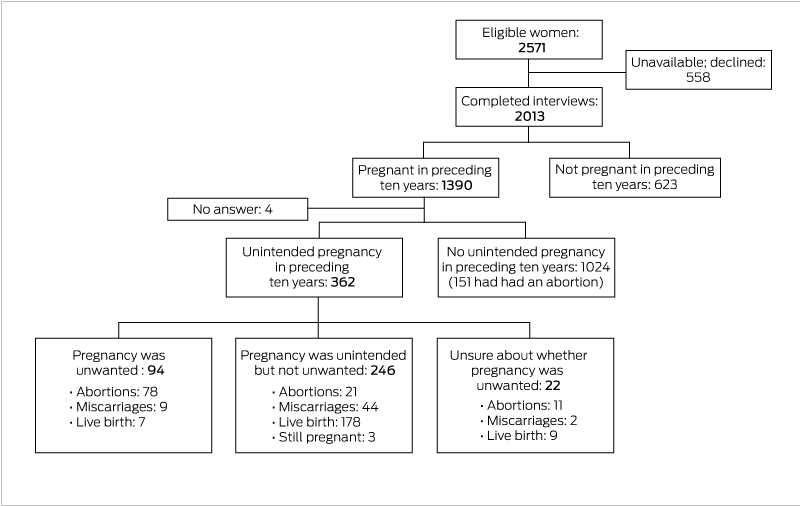Planned parenthood has important benefits for maternal and infant health. Monitoring and preventing unintended pregnancy is therefore an important public health goal.1 In the only Australian national household survey about mistimed or unintended pregnancy (undertaken 2005), 18% of women of reproductive age (18–44 years) reported that their most recent pregnancy was mistimed, and a further 17% reported that the pregnancy was unwanted.2
We undertook a contemporary national population survey to assess the prevalence and outcomes of unintended pregnancy during the preceding ten years. Trained female interviewers (Hunter Valley Research Foundation) undertook a national random computer-assisted telephone (mobile and landline) survey (weekdays, 9 am–8 pm) during December 2014 – May 2015. Women aged 18–45 years with adequate English were asked whether they had had an unintended pregnancy during the past ten years, and whether any unintended pregnancy was unwanted. We also asked about the outcomes of all pregnancies. A population sample size of 2000 was required to detect a prevalence of unwanted pregnancy of 10–50% with 90% power. La Trobe University Human Research Ethics Committee approved the study (reference, 14-075).
Of 2571 eligible women, 2013 (78.3%) completed interviews. A total of 1390 women (69.1%) had been pregnant during the past ten years, including 362 unintended pregnancies (26%). Most unintended pregnancies (246, 68%) were reported as wanted; 94 (26%) were described as unwanted (Box 1).
Half the women with an unintended pregnancy gave birth (194, 53.6%); 110 (30.4%) had abortions, 55 (15.2%) miscarriages, and three (0.8%) were still pregnant at the time of the survey. Of the women who had been pregnant but did not report an unintended pregnancy, 14.7% (151 of 1024) reported having had an abortion (Box 2).
Twenty-one of the 246 women (8.5%) with unintended but wanted pregnancies reported abortions. Of the 94 women with unwanted pregnancies, 78 (83%) had abortions, nine (10%) had miscarriages, and seven (8%) carried the pregnancy to term. A total of 261 of 1390 women who had been pregnant (18.8%) reported abortions (Box 1).
Most women who had unintended pregnancies (205 of 362, 56.6%) reported not having used contraception at the time. Of the 150 women (41.4%) who had an unintended pregnancy while using contraception, 96 (64%) had used oral contraceptives and 40 (26.9%) had used condoms as their primary methods; nine (6%) were using long-acting reversible contraception (Box 2).
In summary, about one in four of our respondents (26%) had fallen pregnant in the past ten years without planning to do so, and 30.4% of unintended pregnancies ended in abortions. Nearly one in five women who had been pregnant (18.8%) reported having had an abortion, but the proportion is likely to have been depressed by under-reporting on this sensitive topic.
Despite the availability of effective contraception in Australia, we found that, as in the United States,3 about half of the unintended pregnancies were in women not using contraception. Research is required to explore the reasons for not doing so, and to determine where education would be most helpful.4 Clinicians and services should focus their attention on women at highest risk of unintended pregnancy, including those who have had three or more pregnancies. The immediate post partum and post-abortion periods are opportune times for intervening to avert unintended pregnancies.
Box 1 – Overview of the 2013 participants in a random national telephone survey of women aged 18–45 years about unintended pregnancy

Box 2 – Characteristics of 362 survey participants who had had an unintended pregnancy during the past 10 years
|
Characteristic |
|
||||||||||||||
|
|
|||||||||||||||
|
Age at time of conception, years (358 respondents) |
|
||||||||||||||
|
14–19 |
42 (12%) |
||||||||||||||
|
20–24 |
66 (18%) |
||||||||||||||
|
25–29 |
99 (28%) |
||||||||||||||
|
30–34 |
88 (25%) |
||||||||||||||
|
35–39 |
53 (15%) |
||||||||||||||
|
≥ 40 |
10 (3%) |
||||||||||||||
|
Practised contraception at the time of unintended pregnancy |
|||||||||||||||
|
Yes |
150 (41.4%) |
||||||||||||||
|
No |
205 (56.6%) |
||||||||||||||
|
Don't remember |
7 (2%) |
||||||||||||||
|
Primary contraceptive method (149 respondents) |
|
||||||||||||||
|
Oral contraceptive pill |
95 (64%) |
||||||||||||||
|
Condoms |
40 (27%) |
||||||||||||||
|
Long-acting reversible contraception |
9 (6%) |
||||||||||||||
|
Diaphragm/contraceptive vaginal ring |
2 (1%) |
||||||||||||||
|
Withdrawal/emergency contraception |
3 (2%) |
||||||||||||||
|
Pregnancy wantedness |
|
||||||||||||||
|
Wanted |
246 (68%) |
||||||||||||||
|
Unwanted |
94 (26%) |
||||||||||||||
|
Not sure |
22 (6%) |
||||||||||||||
|
Parent/step-parent at the time of unintended pregnancy |
|||||||||||||||
|
Yes |
191 (52.8%) |
||||||||||||||
|
No |
171 (47.2%) |
||||||||||||||
|
Outcome of unintended pregnancy |
|
||||||||||||||
|
Live birth |
194 (53.6%) |
||||||||||||||
|
Abortion/termination |
110 (30.4%) |
||||||||||||||
|
Miscarriage |
55 (15%) |
||||||||||||||
|
Still pregnant |
3 (0.8%) |
||||||||||||||
|
|
|||||||||||||||
|
|
|||||||||||||||
Received 6 November 2017, accepted 13 March 2018





We acknowledge with gratitude the contributions of Philip Goldstone and Kerry Petersen, and funding support from Women’s Health Around Victoria, The Roberta Holmes Transition to Contemporary Parenthood Program, and La Trobe University. We also acknowledge the contribution of the Hunter Valley Research Foundation to this study, and thank the women who participated in the survey.
No relevant disclosures.